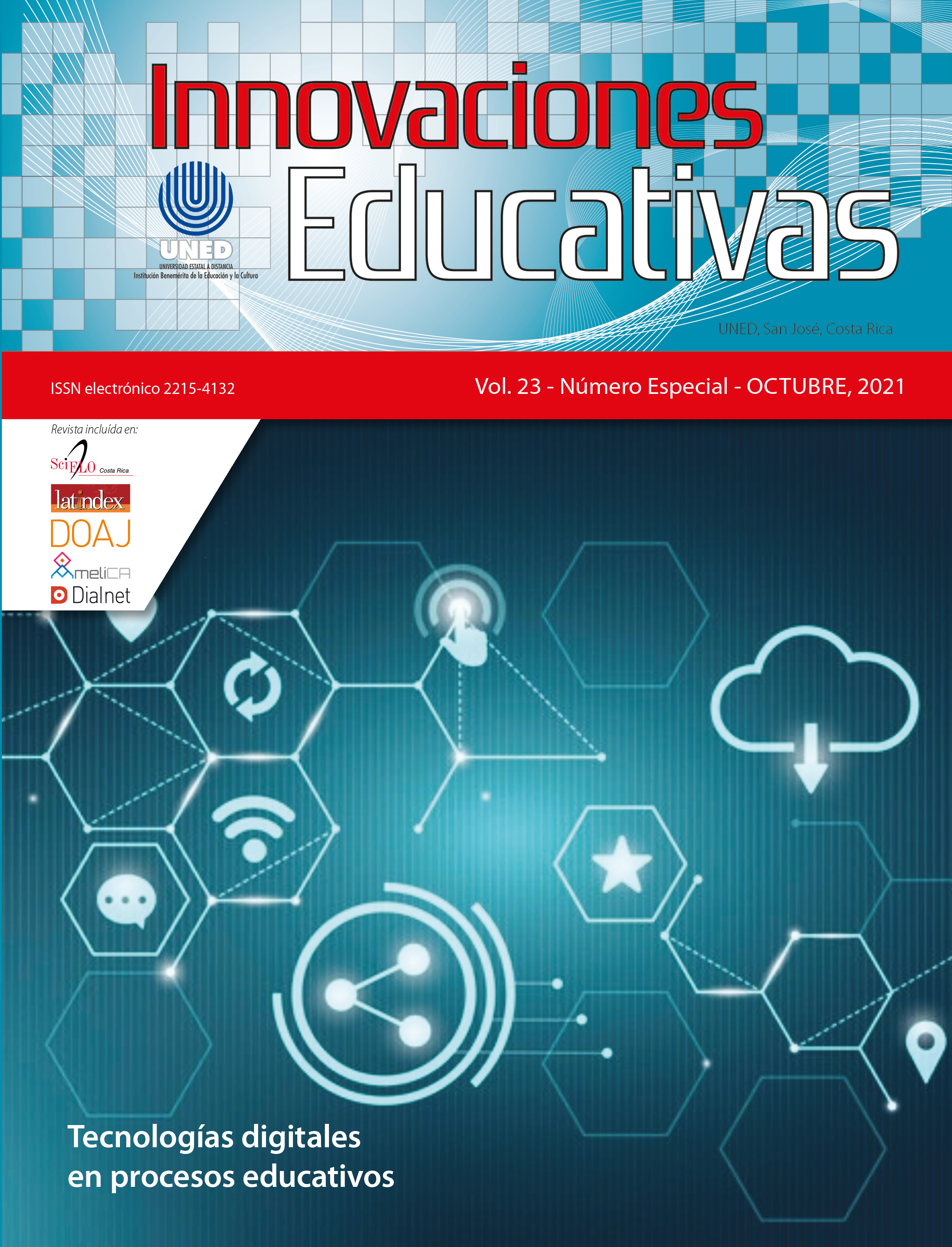Effectiveness of the resources and technological applications used by the teaching population of the José Trinidad Mora Valverde School, Costa Rica in the period July to September 2020
DOI:
https://doi.org/10.22458/ie.v23iEspecial.3475Keywords:
Distance education, information technology, teaching role, pandemic, researchAbstract
This article contemplates the main results of the research, the purpose of which was to analyze the effectiveness of the resources and technological applications selected by the teaching population of the José Trinidad Mora Valverde School of Costa Rica, for the development of the pedagogical mediation processes in the period from July to September 2020. The research approach was mixed. Among the main results obtained, it stands out that teachers have prioritized cell phones as a technological resource for pedagogical mediation processes. This inasmuch as it is the means to which they have the best access and through which they have the best communication with children and parents. In addition, this group of participants shows a great commitment to generate effective spaces in order to favor pedagogical mediation, with the support of technologies. However, their little experience in the use of resources and technological applications for educational purposes is evident. Among the conclusions, it is highlighted that teachers are giving priority to the use of Microsoft Teams® and WhatsApp® technological applications for educational purposes, and for the “I learn at home” strategy implemented by the Ministry of Public Education, since these two applications are the most used by teachers. In addition, the need to strengthen training for the best use of the various technological applications available for teaching and learning processes is clear.
References
Acuña, M. (2017). WhatsApp como herramienta educativa. Obtenido de https://www.evirtualplus.
com/whatsapp-como-herramienta-educativa/
Asociación educación abierta (2018). Los recursos tecnológicos evolucionan a tal ritmo que el docente
se halla en un proceso de constante formación. Obtenido de https://educacionabierta.org/
los-recursos-tecnologicos-evolucionan-a-tal-ritmo-que-el-docente-se-halla-en-un-proceso-deconstante-
formacion/
Cordero, J.; De Roux, M.; Jiany, R.; Wong, L.; Cattafi, R. (2018). Recursos didácticos aplicados a la educación.
En: Revista Investigación, pensamiento crítico. Vol. 6, No. 3, septiembre-diciembre, pp.
-46.
Distancia, U. I. (2019). Estrategias para la enseñanza a través de Zoom. Obtenido de http://www.
ucmconecta.edu.co/wp-content/uploads/2020/03/3.-Guia-estrategias-para-la-enseanza-a-travs-
de-la-plataforma-zoom-profesores.pdf
García, C.; López de Ayala, M.; López, A.; Garcíá, C.(2014): “Los riesgos de los adolescentes en Internet:
los menores como actores y víctimas de los peligros de Internet”. Revista Latina de Comunicación
Social, 69, pp. 462 a 485. http://www.revistalatinacs.org/069/paper/1020_UR/23es.html DOI:
4185/RLCS-2014-1020.
Hernández, C; Gómez, D. y Bladeras, M. (2014). Tecnologías de la información y la comunicación. En:
Revista Electrónica Actualidades Investigativas en Educación.Volumen 14, Número 3 Setiembre -
Diciembre pp. 1-19 ISSN 1409-4703. Obtenida de: https://revistas.uma.es/index.php/innoeduca/
article/view/4956/5031
Martínez-Garrido, C. (2018). Utilidad de los recursos tecnológicos en educación. En: Innoeduca.
International Journal of Technology and Educational Innovation. Vol. 4. No. 2. Diciembre 2018pp.
-149 ISSN: 2444-2925 DOI: http://dx.doi.org/10.24310/innoeduca.2018.v4i2.4956
Mazas, C. R. (marzo de 2021). Qué es y para qué sirve Microsoft Teams. Recuperado de https://andro4all.
com/guias/apps-android/que-es-y-para-que-sirve-microsoft-teams
Ministerio de Educación Pública (2019). Propuesta de Pruebas FARO. San José, Costa Rica: MEP.
Muñoz-Quezada, P.(2006). Educación y efectividad. En: Revista iberoamericana de educación,
Obtenido de: https://www.researchgate.net/publication/28106768
Palmucci, M. (2015). El docente en la escena del aula y el uso de las TIC en su estrategia educativa.
Recuperado de: http://fido.palermo.edu/servicios_dyc/publicacionesdc/vista/detalle_articulo.
php?id_articulo=11010&id_libro=535.
Programa del Estado de la Nación (2019). Informe del estado de la educación. Recuperado de: informe_
estado_nacion_2019.pdf (estadonacion.or.cr)
Smith. (s.f.). El tesoro del saber tecnológico. Obtenido de https://sites.google.com/site/
eltesorodelsabertecnologico/el-papel-deldocente-en-la-era-digital
Soriano. (2020). Obtenido de https://theke.info/2020/09/28/las-competencias-digitales-en-el-ambitoeducativo/
Universidad Estatal a Distancia (2013). Glosario de términos curriculares. San José, Costa Rica: UNED.

